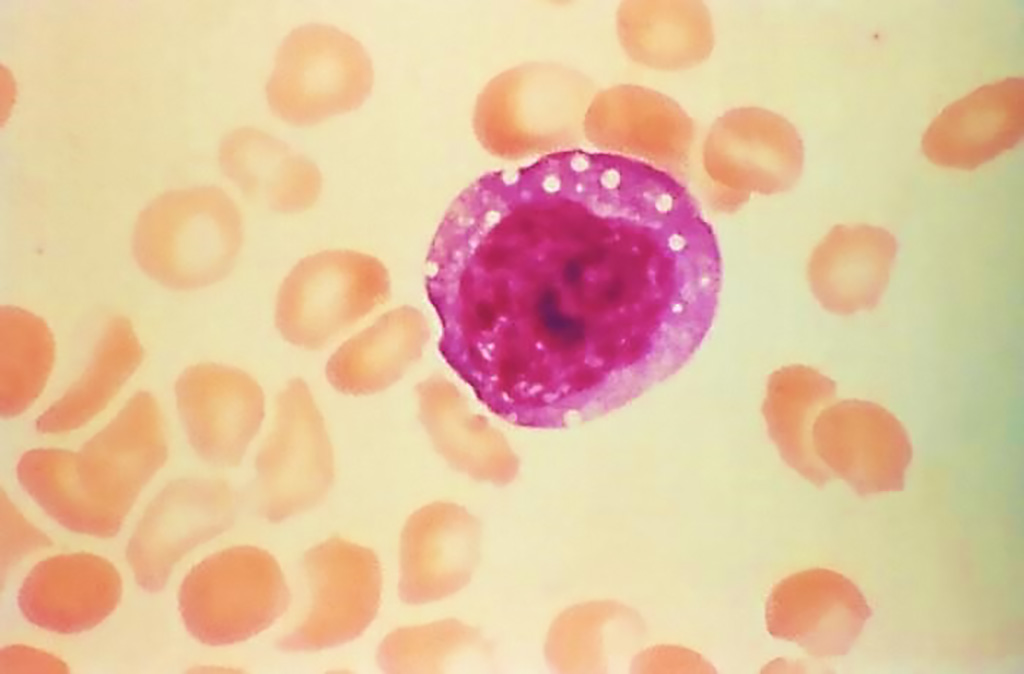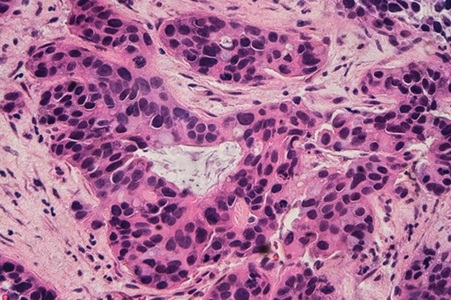Molecular Assays Developed for Hantavirus Pulmonary Syndrome
|
By LabMedica International staff writers Posted on 16 Jan 2020 |

Image: This micrograph depicts an atypical, enlarged lymphocyte found in the blood smear from a hantavirus pulmonary syndrome (HPS) patient. This large atypical lymphocyte is an example of one of the laboratory findings, which when combined with a bandemia, i.e., immature white blood cells, and dropping platelet count, is characteristic of HPS (Photo courtesy of Centers for Disease Control and Prevention)
Hantavirus Pulmonary Syndrome (HPS) is a serious and often fatal disease caused by viruses known as hantaviruses. These anthropozoonotic diseases comprising of two clinical entities: Hemorrhagic Fever with Renal Syndrome (HFRS), which occurs in the Old World, and Hantavirus Pulmonary Syndrome (HPS) in the New World.
Laboratory diagnosis of HPS is often conducted by enzyme-linked immunosorbent assay (ELISA) for detection of immunoglobulin G (IgG) and IgM specific antibodies in serum or blood of suspected patients. Given that IgM antibodies are detectable early in the disease, IgM ELISA is considered the reference method for HPS diagnostics.
Scientists at the Evandro Chagas Institute (Ananindeua, Brazil) have developed real-time polymerase chain reaction (RT-qPCR) and semi-nested RT-qPCR assays for the diagnosis of HPS. The assays were developed for detection and quantification of four hantaviruses strains circulating in the Brazilian Amazon. assays were used to test two groups of samples: one comprising of 50 patients with disease and other containing samples from 50 healthy individuals according to IgM-ELISA results. A third group of 27 samples infected with other pathogens were tested for specificity analysis.
A consensus region in the N gene of these hantaviruses was used to design the primer sets and a hydrolysis probe. In vitro transcribed RNA was diluted in standards with known concentration. MS2 bacteriophage RNA was detected together with hantavirus RNA as an exogenous control in a duplex reaction. RT-qPCR efficiency was around 100% and the limit of detection was 0.9 copies/μL of RNA for RT-qPCR and 10 copies/μL of RNA for Semi-nested RT-PCR. There was no amplification of either negative samples or samples positive to other pathogens. Sample reactions were performed in triplicate in ViiA7 qPCR System (Applied Biosystems, Thermo-Fisher Scientific, Waltham, MA, USA).
The investigators reported that the RT-qPCR was more sensitive than semi-nested RT-PCR, being able to detect three samples undetected by conventional RT-PCR. RT-qPCR clinical sensitivity, specificity and general accuracy values were 92.5%, 100% and 97.63%, respectively. Taken together, these results indicate that both RT-qPCR and Semi-nested RT-PCR assays are efficient, sensitive and specific tools for genome detection of hantaviruses circulating in the Amazon region. In addition to being more sensitive, RT-qPCR offers other advantages such as agility in generating results, about three times faster than conventional assays and automation capability which leads to lower risk of contamination and greater reproducibility. The study was published on December 26, 2019 in the journal Public Library of Science Neglected Tropical Diseases.
Related Links:
Evandro Chagas Institute
Applied Biosystems
Laboratory diagnosis of HPS is often conducted by enzyme-linked immunosorbent assay (ELISA) for detection of immunoglobulin G (IgG) and IgM specific antibodies in serum or blood of suspected patients. Given that IgM antibodies are detectable early in the disease, IgM ELISA is considered the reference method for HPS diagnostics.
Scientists at the Evandro Chagas Institute (Ananindeua, Brazil) have developed real-time polymerase chain reaction (RT-qPCR) and semi-nested RT-qPCR assays for the diagnosis of HPS. The assays were developed for detection and quantification of four hantaviruses strains circulating in the Brazilian Amazon. assays were used to test two groups of samples: one comprising of 50 patients with disease and other containing samples from 50 healthy individuals according to IgM-ELISA results. A third group of 27 samples infected with other pathogens were tested for specificity analysis.
A consensus region in the N gene of these hantaviruses was used to design the primer sets and a hydrolysis probe. In vitro transcribed RNA was diluted in standards with known concentration. MS2 bacteriophage RNA was detected together with hantavirus RNA as an exogenous control in a duplex reaction. RT-qPCR efficiency was around 100% and the limit of detection was 0.9 copies/μL of RNA for RT-qPCR and 10 copies/μL of RNA for Semi-nested RT-PCR. There was no amplification of either negative samples or samples positive to other pathogens. Sample reactions were performed in triplicate in ViiA7 qPCR System (Applied Biosystems, Thermo-Fisher Scientific, Waltham, MA, USA).
The investigators reported that the RT-qPCR was more sensitive than semi-nested RT-PCR, being able to detect three samples undetected by conventional RT-PCR. RT-qPCR clinical sensitivity, specificity and general accuracy values were 92.5%, 100% and 97.63%, respectively. Taken together, these results indicate that both RT-qPCR and Semi-nested RT-PCR assays are efficient, sensitive and specific tools for genome detection of hantaviruses circulating in the Amazon region. In addition to being more sensitive, RT-qPCR offers other advantages such as agility in generating results, about three times faster than conventional assays and automation capability which leads to lower risk of contamination and greater reproducibility. The study was published on December 26, 2019 in the journal Public Library of Science Neglected Tropical Diseases.
Related Links:
Evandro Chagas Institute
Applied Biosystems
Latest Microbiology News
- Rapid Assay Identifies Bloodstream Infection Pathogens Directly from Patient Samples
- Blood-Based Molecular Signatures to Enable Rapid EPTB Diagnosis
- 15-Minute Blood Test Diagnoses Life-Threatening Infections in Children
- High-Throughput Enteric Panels Detect Multiple GI Bacterial Infections from Single Stool Swab Sample
- Fast Noninvasive Bedside Test Uses Sugar Fingerprint to Detect Fungal Infections
- Rapid Sepsis Diagnostic Device to Enable Personalized Critical Care for ICU Patients
- Microfluidic Platform Assesses Neutrophil Function in Sepsis Patients
- New Diagnostic Method Confirms Sepsis Infections Earlier
- New Markers Could Predict Risk of Severe Chlamydia Infection
- Portable Spectroscopy Rapidly and Noninvasively Detects Bacterial Species in Vaginal Fluid
- CRISPR-Based Saliva Test Detects Tuberculosis Directly from Sputum
- Urine-Based Assay Diagnoses Common Lung Infection in Immunocompromised People
- Saliva Test Detects Implant-Related Microbial Risks
- New Platform Leverages AI and Quantum Computing to Predict Salmonella Antimicrobial Resistance
- Early Detection of Gut Microbiota Metabolite Linked to Atherosclerosis Could Revolutionize Diagnosis
- Viral Load Tests Can Help Predict Mpox Severity
Channels
Clinical Chemistry
view channel
Chemical Imaging Probe Could Track and Treat Prostate Cancer
Prostate cancer remains a leading cause of illness and death among men, with many patients eventually developing resistance to standard hormone-blocking therapies. These drugs often lose effectiveness... Read more
Mismatch Between Two Common Kidney Function Tests Indicates Serious Health Problems
Creatinine has long been the standard for measuring kidney filtration, while cystatin C — a protein produced by all human cells — has been recommended as a complementary marker because it is influenced... Read moreHematology
view channel
Platelet Activity Blood Test in Middle Age Could Identify Early Alzheimer’s Risk
Early detection of Alzheimer’s disease remains one of the biggest unmet needs in neurology, particularly because the biological changes underlying the disorder begin decades before memory symptoms appear.... Read more
Microvesicles Measurement Could Detect Vascular Injury in Sickle Cell Disease Patients
Assessing disease severity in sickle cell disease (SCD) remains challenging, especially when trying to predict hemolysis, vascular injury, and risk of complications such as vaso-occlusive crises.... Read more
ADLM’s New Coagulation Testing Guidance to Improve Care for Patients on Blood Thinners
Direct oral anticoagulants (DOACs) are one of the most common types of blood thinners. Patients take them to prevent a host of complications that could arise from blood clotting, including stroke, deep... Read moreImmunology
view channel
Gene Signature Test Predicts Response to Key Breast Cancer Treatment
DK4/6 inhibitors paired with hormone therapy have become a cornerstone treatment for advanced HR+/HER2– breast cancer, slowing tumor growth by blocking key proteins that drive cell division.... Read more
Chip Captures Cancer Cells from Blood to Help Select Right Breast Cancer Treatment
Ductal carcinoma in situ (DCIS) accounts for about a quarter of all breast cancer cases and generally carries a good prognosis. This non-invasive form of the disease may or may not become life-threatening.... Read moreMicrobiology
view channel
Rapid Assay Identifies Bloodstream Infection Pathogens Directly from Patient Samples
Bloodstream infections in sepsis progress quickly and demand rapid, precise diagnosis. Current blood-culture methods often take one to five days to identify the pathogen, leaving clinicians to treat blindly... Read more
Blood-Based Molecular Signatures to Enable Rapid EPTB Diagnosis
Extrapulmonary tuberculosis (EPTB) remains difficult to diagnose and treat because it spreads beyond the lungs and lacks easily accessible biomarkers. Despite TB infecting 10 million people yearly, the... Read more
15-Minute Blood Test Diagnoses Life-Threatening Infections in Children
Distinguishing minor childhood illnesses from potentially life-threatening infections such as sepsis or meningitis remains a major challenge in emergency care. Traditional tests can take hours, leaving... Read more
High-Throughput Enteric Panels Detect Multiple GI Bacterial Infections from Single Stool Swab Sample
Gastrointestinal (GI) infections are among the most common causes of illness worldwide, leading to over 1.7 million deaths annually and placing a heavy burden on healthcare systems. Conventional diagnostic... Read morePathology
view channel
AI Tool Improves Breast Cancer Detection
Breast cancer diagnosis relies on examining microscopic tissue samples, a time-intensive process made more challenging by global shortages of trained pathologists. Delays in diagnosis can lead to missed... Read more
AI Tool Predicts Treatment Success in Rectal Cancer Patients
Artificial intelligence (AI) may soon help clinicians identify which rectal cancer patients are likely to respond well to treatment, using only the routine biopsy slides already obtained at diagnosis.... Read moreTechnology
view channel
AI Saliva Sensor Enables Early Detection of Head and Neck Cancer
Early detection of head and neck cancer remains difficult because the disease produces few or no symptoms in its earliest stages, and lesions often lie deep within the head or neck, where biopsy or endoscopy... Read more
AI-Powered Biosensor Technology to Enable Breath Test for Lung Cancer Detection
Detecting lung cancer early remains one of the biggest challenges in oncology, largely because current tools are invasive, expensive, or unable to identify the disease in its earliest phases.... Read moreIndustry
view channel
Abbott Acquires Cancer-Screening Company Exact Sciences
Abbott (Abbott Park, IL, USA) has entered into a definitive agreement to acquire Exact Sciences (Madison, WI, USA), enabling it to enter and lead in fast-growing cancer diagnostics segments.... Read more









 assay.jpg)












